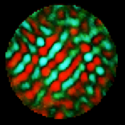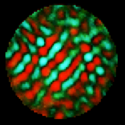Getting the “where” and “when” of magnetic nanostructures
When studying magnetic structures, size and shape are as important as dynamics. For this reason it is desirable to obtain not only temporal but also spatial information about nanoscale magnetic structures. Scanning tunneling microscopy can provide structural information down to atomic scale, whereas optical techniques such as Kerr microscopy can capture dynamics down to the femtosecond. However, simultaneously obtaining spatial and temporal information of nanoscale magnetic structures is a current challenge. A form of lensless imaging called x-ray diffraction microscopy (XDM) has the potential to probe spatial and temporal information simultaneously, and has been particularly useful for biological systems. However, XDM as currently used captures only the charge distribution and not the magnetic information, and has therefore not been useful for magnetic systems.
Writing in Physical Review Letters, Joshua Turner, working at the Linac Coherent Light Source (SLAC National Laboratory, US) and at Stony Brook University, US, and his colleagues use XDM tuned to a resonant absorption edge of cobalt in a terbium-cobalt film. Through analysis techniques from magnetic resonant scattering, the team compares scattering patterns obtained with and without an applied magnetic field, and obtains the magnetic orientation of magnetic domains in the film. An advantage of this technique is that it is not limited to circularly polarized x-rays, but is applicable to any coherent x-ray source, as well as single-shot imaging at free-electron laser sources. A future possibility is to image inside magnetic domain walls to obtain pinning densities and hence gain further understanding of domain wall motion. At sufficient resolution, imaging individual spins may be possible, with important implications for, e.g., spintronics. – Daniel Ucko





